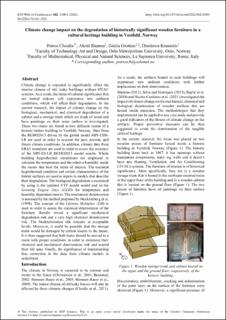Climate change impact on the degradation of historically significant wooden furniture in a cultural heritage building in Vestfold, Norway
Peer reviewed, Journal article
Published version
Permanent lenke
https://hdl.handle.net/11250/3050078Utgivelsesdato
2022-12-01Metadata
Vis full innførselSamlinger
Sammendrag
Climate change is expected to significantly affect the interior climate of old, leaky buildings without HVAC systems. As a result, the items of cultural significance that are hosted indoors will experience new ambient conditions, which will affect their degradation. In the current research, the impact of climate change on the biological, mechanical, and chemical degradation of a cabinet and a storage trunk which are made of wood and have paintings on their outer surface is investigated. These two items are found in two different rooms of a historic timber building in Vestfold, Norway. Data from the REMO2015 driven by the global model MPI-ESM-LR are used in order to account for past, present, and future climate conditions. In addition, climate data from ERA5 reanalysis are used in order to assess the accuracy of the MPI-ES-LR_REMO2015 model results. Whole building hygrothermal simulations are employed to calculate the temperature and the relative humidity inside the rooms that host the items of interest. The transient hygrothermal condition and certain characteristics of the timber surfaces are used as inputs in models that describe their degradation. The biological degradation is examined by using i) the updated VTT mould model and ii) the Growing Degree Days (GDD) for temperature and humidity dependant insects. The mechanical deterioration is assessed by the method proposed by Mecklenburg et al. (1998). The concept of the Lifetime Multiplier (LM) is used in order to assess the chemical deterioration of the furniture. Results reveal a significant mechanical degradation risk and a very high chemical deterioration risk. The biodeterioration risk remains at acceptable levels. Moreover, it could be possible that the storage trunk would be damaged by certain insects in the future. It is then suggested that both items should be moved to a room with proper conditions in order to minimize their chemical and mechanical deterioration risk and extend their life span. Finally, the significance of implementing bias correction in the data from climate models is underlined.

